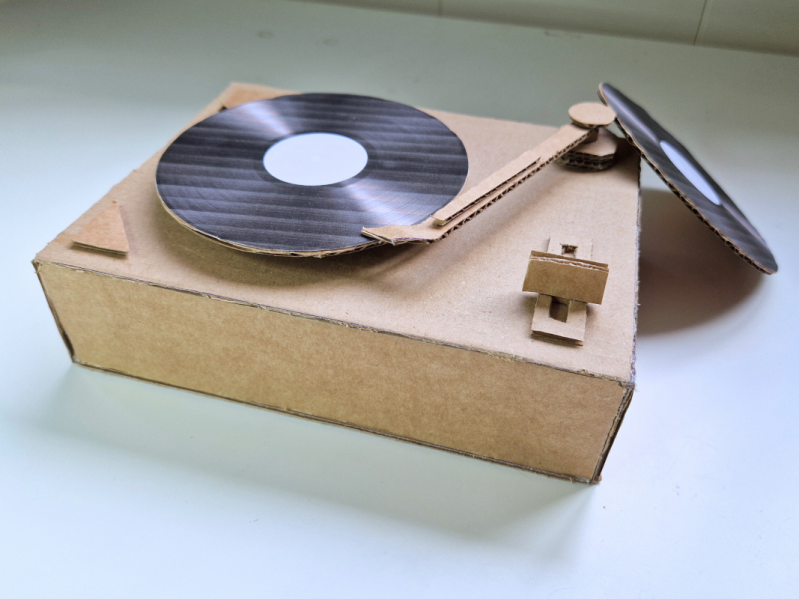Cardboard is a surprisingly durable material, especially in its corrugated form. It’s extremely lightweight for its strength, is easy to work, can be folded and formed into almost any shape, is incredibly inexpensive, and when it has done its duty it can be recycled back into more paper. For these reasons, it’s often used in packaging material but it can be used to build all kinds of things outside of ensuring that products arrive at their locations safely. This working cardboard record player is one example.
While the turntable doesn’t have working records in the sense that the music is etched into them like vinyl, each has its own RFID chip embedded that allows the ESP32 in the turntable’s body to identify them. Each record corresponds to a song stored on an SD card that instructs the ESP32 to play the appropriate song. It also takes care of spinning the record itself with a small stepper motor. There are a few other details on this build that tie it together too, including a movable needle arm held on with a magnet and a volume slider.
As far as a building material goes, cardboard is fairly underrated in our opinion. Besides small projects like this turntable, we’ve also seen it work as the foundation for a computer, and it even has the strength and durability to be built into a wall or even used as shelving material. And, of course, it’s a great material to use when prototyping new designs.
















this not working ;(
I remember a good idea to save sound on plastic cup transparent. very nice idea. this device not work, it only symulatet working vinyl
There was a while back a freebie “record player” made out of cardboard where the cardboard itself amplified the sound in the same way a gramophone’s diaphragm does.
The only non-card bit was a stylus made out of a sewing needle or pin.
So you could play real records with cardboard, but you had to manually spin them at the right speed…
Yeah, I think I saw that you can get fancy wedding invitation cards like that. You could even do it without the pin – if you roll a fresh sheet of ~90gsm copy paper into a cone, using the sharp corner as a needle, you can get surprisingly good mono reproduction from a vinyl record. It does work better with plastic banknotes, if you live in a regime that has those.
Continuing with the money theme, you could also use coins as a standardised weight to drive a papercraft record player at constant speed. Wrap 30 seconds’ worth of thread around the axle, tie an envelope with the correct change to the free end, and let it drop off a table…
Interesting!
I hadn’t heard of the coin thing before.
I mean, I made that up, I haven’t seen anyone do it. But an unspooling weight + friction is a good way to get constant speed. And coins are great for maker projects, because they have reliable mass and dimensions, and everyone has them.
It’s especially good for UK makers, who have manhole-sized 2p coins to get rid of.
Yep, can confirm – currently got hundreds of pounds of copper lying around in 2p pieces!
It’s a good idea, and add some kind of viscous restriction like the “fan” in a music box player, or something spinning in thick liquid, or a centrifugal governor would be a big improvement. Simple friction is unstable and not much simpler, but still worth a try 👍
“Cardboard is a surprisingly durable material, especially in its corrugated form”
No it’s not.
As a packaging material for deliveries, its service life does not need to be longer than the duration of the delivery. And in particular as deliveries are no longer made by ox cart, the cardboard is therefore protected from bad weather because it is very sensitive to humidity. Plus the usual color of the cardboard is not very sexy!
But it is indeed a very good & cheap material for ephemeral toys for children that they can make themselves, or a castle for the cat, in the same way that bricks and recycled boards can make shelves for penniless students (pleonasm). Or wooden pallets to make a bed/sofa.
Even if cardboard work is very pleasant to do for training children’s manual dexterity, it is not exactly a success in terms of aesthetics and durability.
Yes it is, but you need to use it properly.
Throwing the cheapest single wall box in and out delivery trucks (all day long) isn’t the best purpose for making things last. Funny thought that sometimes the box last longer than what’s inside, depending on what you ordered and who’s doing the transport.
I have various cardboard boxes holding my stuff stored in the attic, for over decades without problems. These are simple boxes from the supermarket, intended for holding bananas, extremely tough. But the most interesting is that they are free and can be found at the cash register area.
You speak of items stored in an attic as proof that cardboard is durable. Could you not have stored those same items, covered with a sheet, to achieve the same results?
You can close and stack boxes quite tall without crushing the items within, for one thing. And for another, you could say that cars are durable, but then the rust belt brings out the road salt and they fall apart, so conditions do matter.
First thing I thought of when I saw this article:
https://www.amazon.com/SUCK-UK-CARDBOARD-TURNTABLE-MIXER/dp/B006YR6EK8
I’m surprised I’m the first one who was instantly reminded of this product!
Does it play “Cat Scratch Fever”?
B^)
This is totally fake, the music starts before the pin hits…
The video is fake